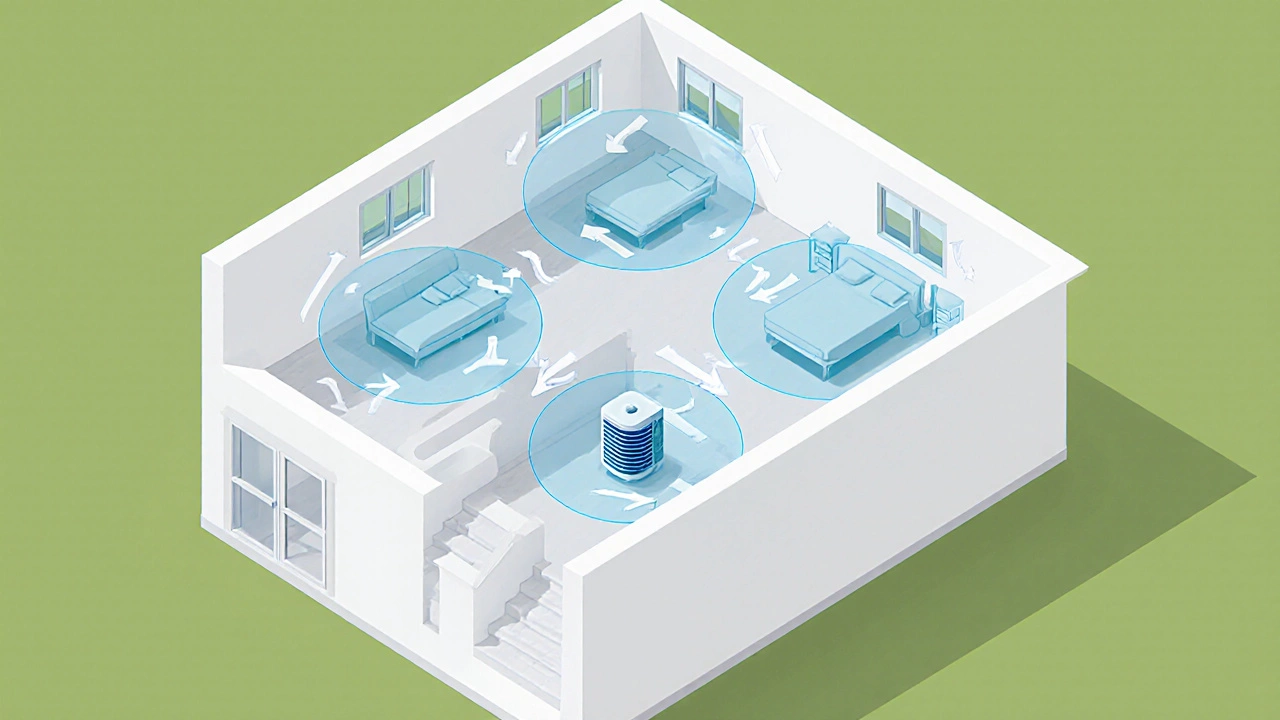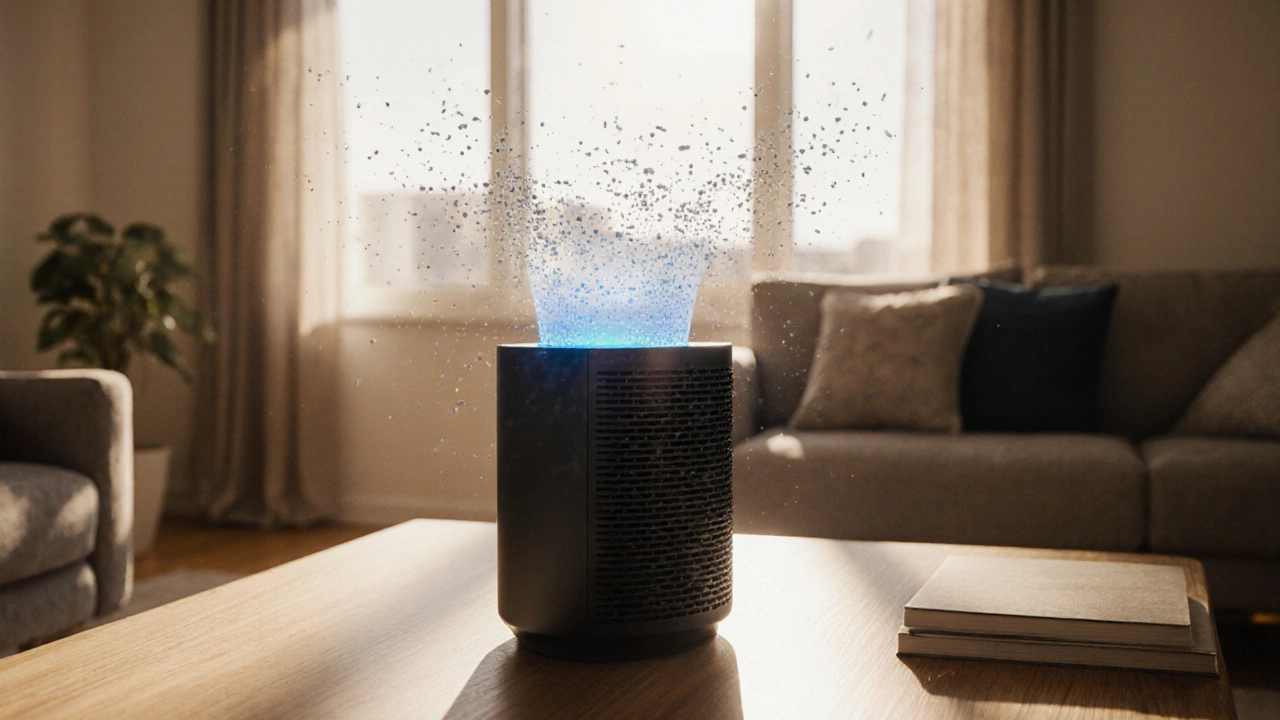Air Purifier Coverage Calculator
Results
When you wonder if Air Purifier is a device that filters airborne particles, gases, and odors to improve indoor air quality can handle a whole‑house load, the answer isn’t a simple yes or no. It boils down to the purifier’s performance specs, the size and layout of your home, and the type of pollutants you’re trying to eliminate.
What Determines a Purifier’s Coverage?
The two technical metrics you’ll hear most often are Clean Air Delivery Rate (CADR) a rating that measures how many cubic feet of filtered air a unit can deliver per minute and the recommended square‑foot coverage published by the manufacturer. CADR is expressed in three numbers - for dust, pollen, and smoke - and the higher the figure, the faster the unit can clean a given volume of air.
To translate CADR into real‑world coverage, use the simple formula:
- Multiply the CADR (in cubic feet per minute) by 60 to get cubic feet per hour.
- Divide that number by the room’s volume (square feet × ceiling height).
- The result is the number of air changes per hour (ACH) the purifier can achieve.
Most health experts recommend at least 4-5 ACH for allergy‑prone households and 6-8 ACH for smoke‑affected spaces. If your calculation falls short, you’ll need a bigger unit or additional units.
Types of Pollutants and Filter Requirements
Not all pollutants are captured equally. HEPA Filter a high‑efficiency filter that traps 99.97% of particles down to 0.3 microns is essential for dust, pollen, and most airborne microbes. However, gases like formaldehyde or cooking odors require activated carbon or specialized VOCs volatile organic compounds that evaporate at room temperature filters.
When a purifier lists a PM2.5 particulate matter 2.5 micrometers or smaller, known for deep‑lung penetration rating, it usually means the HEPA media is capable of handling fine particles that trigger asthma and cardiovascular issues.
Single‑Unit Scenarios: Small, Medium, and Large Homes
Small apartments (up to 500 sq ft): A unit with a CADR of 250-300 cfm typically reaches 5-6 ACH, easily handling dust and pollen. Models like the Levoit Core 400S or Coway AP‑1512HH fit this bracket.
Medium houses (500‑1,200 sq ft): You’ll need a purifier with a CADR of 350-450 cfm. The win‑win is a device that supports both HEPA and carbon layers, such as the Blueair Classic 680i. Position it in the most trafficked area (living room or open‑plan kitchen) for best circulation.
Large homes (1,200‑2,500 sq ft): Even the most powerful standalone units (e.g., Dyson Pure Hot+Cool Form‑E with CADR ≈ 450 cfm) will struggle to achieve the desired ACH across multiple floors. You’ll notice zones where the air stays stale, especially in closed‑off rooms.
In these larger layouts, the limitation isn’t just raw airflow - it’s the path the air takes. Stairwells, closed doors, and HVAC zones create barriers that a single purifier can’t overcome.

When Multiple Units Make Sense
Dividing the load among two or three strategically placed purifiers often yields better results than buying one giant machine. Here’s why:
- Uniform coverage: Each unit can service a defined zone, ensuring the recommended ACH is met everywhere.
- Noise management: Smaller units run at lower fan speeds, keeping overall noise levels down.
- Redundancy: If one unit fails, the others keep the house partially protected.
Below is a quick comparison to help you decide which approach fits your home.
| Feature | One Large Unit | Multiple Small Units |
|---|---|---|
| Typical Coverage | 1,200‑1,800 sq ft | 3 × 400‑600 sq ft each (total 1,200‑1,800 sq ft) |
| Cost (USD) | $500‑$800 | $300‑$450 × 3 = $900‑$1,350 |
| Installation | Plug‑and‑play, single spot | Plug‑in multiple locations, may need power strips |
| Noise (dB at max) | 55‑60 dB | 45‑50 dB each (combined ≈ 48 dB) |
| Maintenance (filter swaps) | 1‑year HEPA, 6‑month carbon | Same schedule per unit, but cost adds up |
Placement Tips for Maximum Efficiency
Regardless of how many units you use, placement dramatically influences performance. Follow these rules:
- Place the purifier on a hard surface, at least 2‑3 ft off the ground.
- Keep it at least 3 ft away from walls or large furniture to avoid restricted airflow.
- Locate the unit in the room where you spend the most time - living rooms, master bedrooms, or home offices.
- Avoid placing it directly in front of air‑conditioner vents, as the forced air can short‑circuit circulation.
- In multi‑story homes, put a unit on each floor’s central hallway for balanced distribution.
Smart Features and Integrated Systems
Modern purifiers often bundle Wi‑Fi, air‑quality sensors, and app control. A Smart Air Purifier connects to a mobile app to report real‑time PM2.5 levels and adjust fan speed automatically can save energy by ramping down when indoor air is clean.
If you already have a central HVAC system, consider a whole‑home filtration add‑on that uses MERV‑13 or higher filters. While not a replacement for room‑level purifiers, an HVAC Integration installing high‑efficiency filters within your existing ductwork helps trap particles before they reach individual rooms, reducing the load on portable units.
Bottom Line Checklist
- Calculate your home’s total square‑footage and ceiling height.
- Determine the CADR needed to achieve 4‑6 ACH for your primary pollutants.
- If a single unit meets the calculated CADR, choose the model with HEPA + carbon for comprehensive coverage.
- For homes over 1,500 sq ft or with multiple floors, plan a multi‑unit layout using the zone‑based approach.
- Place each purifier in open, central locations and keep airflow pathways clear.
- Leverage smart sensors to maintain optimal fan speeds without wasting electricity.
In short, a lone air purifier can clean an entire house *only* if the device’s CADR and coverage rating match or exceed the house’s volume, and if the home’s layout doesn’t create dead‑air zones. Otherwise, a distributed system of two or three units, possibly complemented by HVAC filtration, is the realistic path to breath‑easy living.
Frequently Asked Questions
What CADR do I need for a 2,000 sq ft home?
Aim for a total CADR of at least 400 cfm per floor. For a two‑story, 2,000 sq ft house, a combination of two 250-300 cfm units (one per floor) will usually meet the 5‑ACH recommendation.
Do I need a separate purifier for the kitchen?
If you cook often and notice lingering odors, a kitchen‑oriented unit with a strong activated carbon layer works best. Placing it near the stove but away from direct heat will capture both smoke and VOCs.
Can a purifier with a HEPA filter alone remove allergens?
Yes, a true HEPA filter traps 99.97% of particles down to 0.3 µm, covering most common allergens like pollen, dust mites, and pet dander.
Is it worth adding an air purifier to an already filtered HVAC system?
If your HVAC filter is only MERV‑8, adding a portable HEPA+carbon purifier in high‑traffic rooms can dramatically improve indoor air quality. For severe smoke or chemical exposure, a dedicated unit is still recommended.
How often should I replace the filters?
HEPA filters typically last 12 months, while activated carbon filters may need changing every 3‑6 months if you run the unit continuously in a polluted environment.

